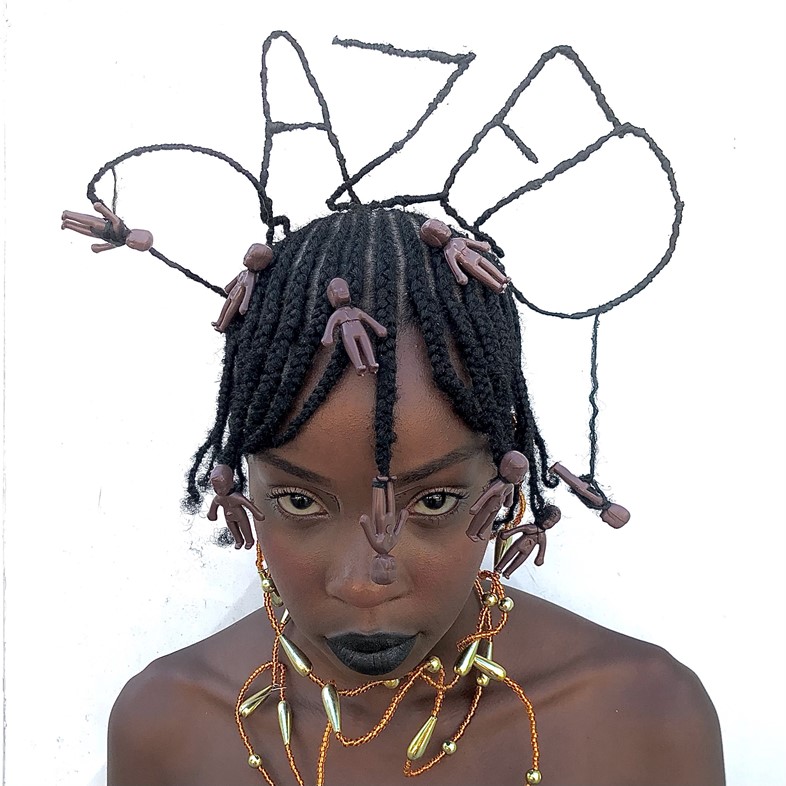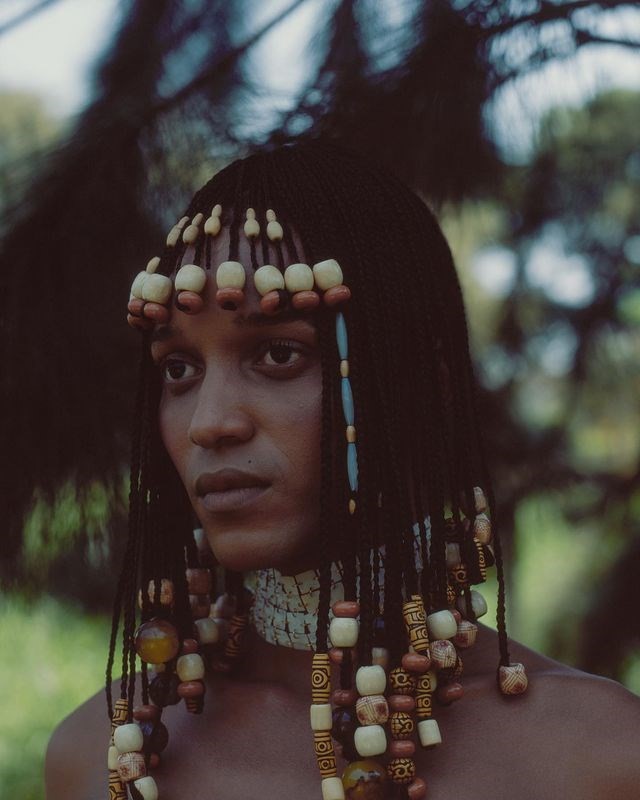The Brazilian artist and braider shares how the Afro-Brazilian Candomblé religion inspires her work and the challenges of expanding western perspectives that ignore creatives from the global south
As the daughter of a manicurist, who dreamed of being a hairdresser, but unfortunately never had the money to invest in a course, Brazilian hairstylist Janice Mascarenhas grew up around the salon where her mother worked. “Although it is often a hostile environment, it is also a place that has the power of mutation,” says the Rio-born artist, currently top 5 on Newlife.ai, the cryptocurrency-powered platform with a stamp of approval from creatives worldwide – where she showcases her creations and notable Carioca lifestyle. “I watched my mother and her co-workers rebuild people’s self-esteem with their hands and I fell in love with that space.”
In a scene from the 2007 documentary “I Told You I Was Trouble”, Amy Winehouse says that the less confident she was in herself, the bigger her hairstyle became. Mascarenhas saw this while she was growing up and the film presented her with an escape from the social impositions of daily life in Brazil. As a Black person living in a favela, she suffers from the attempt of having her identity be homogenised by the dominant, Eurocentric canons. For other people like her, growing up they have their self-esteem wiped out by the media, which most often leads them to straightening their Afro hair. However, despite also having straightened her hair in the past, nowadays Janice builds up volume just like Winehouse did, but she no longer hides from the fact that they made her believe she was ugly. She proudly braids herself and others who look like her.
Gradually, Mascarenhas discovered her talent for braiding by pure intuition. After attending the Afro-Brazilian religion Candomblé, she discovered that the yabás – the female orishas, mediators between the human and spiritual realm – braided each other’s hair as a way of predicting the future, developing clairvoyance and weaving paths. “When I discovered that my yabá also braided hair, I was shocked, but at the same time very happy, because I realised that my work is something that comes from within. The braids are what sets me free and help me to discover new paths,” she says.
She continues: “While I stand for so long, whenever I’m braiding someone else’s hair, I think of many paths and resolutions and leave the client’s house with a future outlined beyond the constraints of money.” In her own words, if it were not for the braids, her art would not exist. For a long time she denied her talent for hairstyling, because, initially, she wanted to be an artist and to be showcased in galleries. However, faced with early motherhood and in need of a quick sort of income, she started braiding for survival. Acknowledging her family inheritance, she finally recognised the possibility of creating art on people’s heads and also on her own.

From a structure of dreadlocks that outline the spelling of the name ‘Dazed’, with dolls that hang from it in honour of Awn Iyá Wa (our mothers, as translated from Yoruba), to a different part of the same structure – one from which a thicker dreadlock piece draws a heart. From a hairdo that mixes various thicknesses of dreadlocks, to a mask made out of flowers and braids, the hairstylist takes us on a journey that seems to rejoice hidden routes of her ancestry, which are now pointing us towards different futures.
Since then, moving between music, fashion, and art, Mascarenhas has gathered professional experience working with artists such as singers Urias, Mel, and Deize Tigrona; with Brazilian magazines like Marie Claire, Glamour, and Vogue, as well as working on the cover of South African Bubblegum Club. She recently signed a global campaign for Zara alongside stylist and in 2018 presented a performance around the act of braiding at the CuTie.BI.POC Festival in Berlin.
Although the internet is a tool that legitimises the Western-racial domination behind the idea of modernity and advancement, it has become the main means by which Mascarenhas challenges the limitations posed by the geographical position of the global south and the national identity of a third world country like Brazil, which infuses her work. Be that whether by enabling a platform for sharing work, generating financial support or for building a sort of professional self-esteem, the internet has become an important tool for her. “Although ordinary, the internet is a tool that has the power to connect you with artists from all over the world and is especially important at bringing you confidence in what you do.”
“For centuries all eyes of art have been on the global north. Many of the northern artists who have had merit and recognition were white and European people, who appropriated our narratives simply because at some point their sources were exhausted, or simply because portraying white Europe was no longer interesting” – Janice Mascarenhas
The experience in the global south, Latin America, and Brazil are Janice's main study interests and the headline crossroads of her artistic practice. As an artist from the favela, she makes a point in saying that her main university has been, and still, is the alleys and block walls: the people she meets in such places, the resistance to keep hers and their bodies alive in the face of State violence, and the stories she hears about her ancestors.
For this reason, Mascarenhas’ braids have had a direct impact on her local community. “For centuries all eyes of art have been on the global north. Many of the northern artists who have had merit and recognition were white and European people, who appropriated our narratives simply because at some point their sources were exhausted, or simply because portraying white Europe was no longer interesting,” she highlights. “It is extremely important that the world recognises the originators. In addition to it becoming a way of restoring us since colonisation, this recognition is also a place of gratitude for us having given up our bodies and experiences in the face of totally shallow and incomplete research.”
The artist, who will soon be going to the Asian continent to work, works mainly with valuation: “With the circulation of capital among Black bodies, people around me have believed more in possibilities and a happy future, because if I left a place of extreme financial vulnerability and reached Brazil and countries in Europe, my community realises that the opportunity is an initiative based on self-confidence,” she explains.
“The moment I am braiding is the moment I abandon myself and focus on the other. It requires physical, emotional, and spiritual preparation. I need to forget myself. I arrive at people’s homes, find them feeling bad about themselves, and at the end they give me a hug and say: ‘Thank you very much!’. That’s why I would never stop serving my clients in their own homes, no matter where I am or the place in the world where my work of art, fashion, and music may arrive.”
Since colonisers destroy the mental health of the colonised as a form of domination, reinforcing deteriorating stereotypes of race and geopolitics, causing them to doubt their integrity, art practices such as that of Janice is of the utmost importance. Works like that of the Brazilian artist build a counter-narrative to the deprivation of access leading to the marginalised histories of the very people who live them, as a political project of hegemonic power. Through the beauty and practice of braiding, not only self-esteem may be recovered, but also dreams are restored. Above all, other paths, worlds, and futures unfold.










